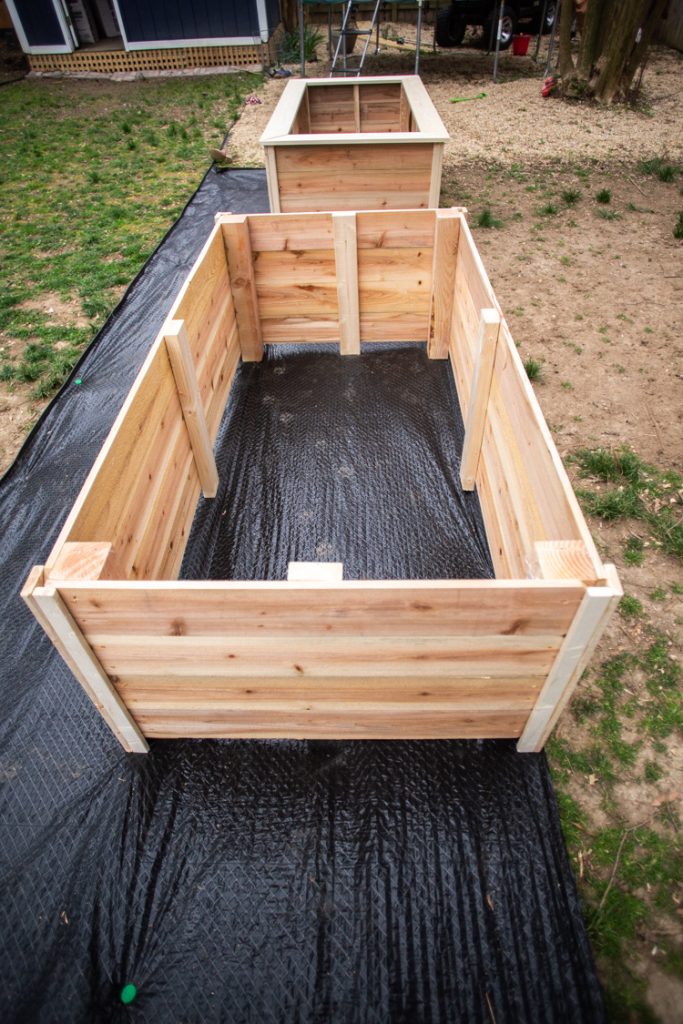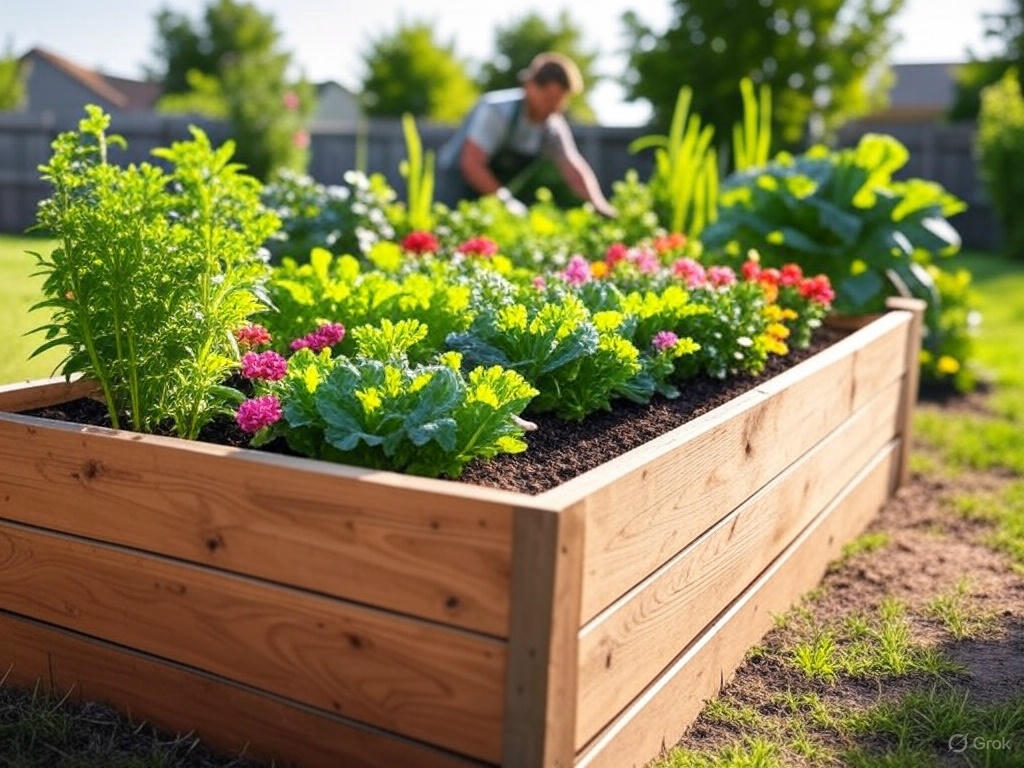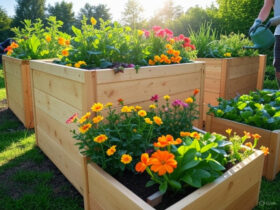Gardening is a rewarding hobby. Raised garden beds make it even better.
They offer better soil control and easier access. Plus, they look great in any yard. Creating raised garden beds doesn’t have to be expensive. Many free plans are available online. These plans help you build garden beds that fit your space and needs.
You’ll find options for various sizes, shapes, and materials. Whether you’re a beginner or an experienced gardener, these plans can guide you. They make the process simple and enjoyable. Ready to start your garden project? Explore these free raised garden bed plans and grow your own fresh produce at home.
Benefits Of Raised Garden Beds
Are you planning to start a garden but feeling overwhelmed? Raised garden bed plans free can be your best friend. Raised garden beds offer many benefits, making gardening easier and more productive. Let’s explore some of these benefits.
Improved Drainage
One of the primary benefits of raised garden beds is improved drainage. Water can drain more effectively through the soil in a raised bed. This prevents waterlogging and ensures that plants receive the right amount of moisture. Let’s break down the benefits:
- Reduced Soil Compaction: Elevated soil reduces the chances of soil becoming compacted, which improves root growth.
- Better Aeration: Proper drainage ensures that soil remains well-aerated. This is vital for plant health.
- Prevents Root Rot: Excess water can cause root rot. Raised beds help in avoiding this issue.
For those dealing with heavy rainfall or poorly draining soil, raised garden bed plans free can be a game-changer. You can even design a u shaped raised bed for better water distribution. Using raised bed corners can also help in building sturdy and well-draining beds.
Table of Contents
Easier Access
Another significant advantage is easier access. Raised garden beds can be built at a height that reduces the need to bend or kneel. This is especially beneficial for older gardeners or those with mobility issues. Here’s why:
- Less Strain: Working at a comfortable height reduces back and joint strain.
- Better Reach: Raised beds, especially u shaped raised beds, allow you to reach all parts of the garden easily.
- Accessibility: Gardens can be designed to accommodate wheelchairs and other aids.
Using raised garden box plans free can help you design beds that are easily accessible. You can also consider a corner raised garden bed for smaller spaces. These plans not only make gardening more enjoyable but also more inclusive.

Essential Materials Needed
Creating a raised garden bed can transform your gardening experience. With raised garden bed plans free, you can easily design your perfect garden bed without spending a fortune. The first step in building your raised garden bed is gathering the essential materials needed. This section will discuss the most important materials, including wood options and soil types, to ensure your garden thrives.
Wood Options
Choosing the right wood for your raised garden bed is crucial. The wood must be durable, weather-resistant, and safe for growing food. Here are some popular wood options:
- Cedar: Naturally resistant to rot and insects. It lasts for many years without treatment.
- Redwood: Similar to cedar, redwood is rot-resistant and has a beautiful color.
- Pine: Cheaper than cedar and redwood. It requires treatment to resist rot.
- Reclaimed wood: Eco-friendly and cost-effective. Ensure it is free from chemicals.
When selecting wood, consider the thickness and length for stability. Typically, 2-inch thick boards work best for building sturdy raised beds. You can use raised garden bed plans free for guidance on dimensions and design.
Another option is using raised bed corners to enhance stability and make construction easier. These metal brackets provide support and make assembling the wood pieces straightforward. Raised bed corners are especially useful for creating a corner raised garden bed or a u shaped raised bed.
Here is a table summarizing the wood options:
| Wood Type | Pros | Cons |
|---|---|---|
| Cedar | Rot-resistant, insect-resistant | More expensive |
| Redwood | Rot-resistant, beautiful color | Expensive |
| Pine | Affordable | Needs treatment |
| Reclaimed wood | Eco-friendly, cost-effective | Potential chemical contamination |
Soil Types
Soil is the foundation of a successful garden. Different plants thrive in different soil types. Here are some common soil options for raised garden beds:
- Topsoil: Basic garden soil suitable for most plants. It needs amendments for better fertility.
- Compost: Rich in nutrients and organic matter. Improves soil structure and fertility.
- Potting mix: Lightweight, well-draining soil. Ideal for raised beds and containers.
- Soil blends: Mixture of topsoil, compost, and other amendments. Customizable to your garden’s needs.
When filling your raised garden box plans free, use a combination of topsoil and compost for optimal growth. Compost adds essential nutrients and improves water retention. Potting mix is great for plants requiring excellent drainage.
Here is a table summarizing the soil types:
| Soil Type | Pros | Cons |
|---|---|---|
| Topsoil | Versatile, basic option | Needs amendments |
| Compost | Nutrient-rich, improves soil structure | Requires regular replenishment |
| Potting mix | Lightweight, well-draining | More expensive |
| Soil blends | Customizable, balanced | Varies in quality |
Raised garden bed plans free can guide you in choosing the right soil mix. Remember, the key to a thriving garden is using quality soil that meets your plants’ needs.
Designing Your Garden Bed
Designing your garden bed is an exciting part of creating your garden. Raised garden bed plans free are available to help you with this. You can choose from various designs to suit your space and needs. Let’s dive into some key considerations for designing your raised garden bed.
Size Considerations
The size of your raised garden bed depends on several factors. First, think about the space available in your garden. Larger areas allow for bigger beds, while smaller spaces might need compact designs.
Consider the following points for size:
- Accessibility: Ensure you can reach the center of the bed from all sides. A common size is 4 feet wide, allowing easy access without stepping into the bed.
- Depth: Depth affects root growth. For most vegetables, a depth of 12 to 18 inches is ideal.
- Length: Length depends on your space and needs. Common lengths are 6 to 8 feet.
Here’s a simple table to help you decide:
| Size | Best For |
|---|---|
| 4×4 feet | Small spaces, herbs, and compact plants |
| 4×6 feet | Medium spaces, vegetables, and flowers |
| 4×8 feet | Large spaces, multiple plant varieties |
Shape Variations
The shape of your raised garden bed can add character to your garden. Traditional rectangular beds are common, but other shapes can be more efficient or aesthetically pleasing.
Consider these shape options:
- Rectangular: The most common and easy to construct. Ideal for most garden spaces.
- Square: Great for small spaces. Easy to manage and plan.
- U-shaped Raised Bed: Provides maximum planting area and easy access to all plants.
- L-shaped: Perfect for corner spaces. Maximizes space and accessibility.
Using raised bed corners can help in creating these shapes. They provide stability and ease of assembly.
Here are some examples:
| Shape | Advantages |
|---|---|
| Rectangular | Simple design, easy to build, versatile |
| Square | Compact, easy to maintain, ideal for small gardens |
| U-shaped | Maximizes planting area, easy access |
| L-shaped | Efficient use of corner spaces |
Exploring different raised garden box plans free can inspire you to create a unique garden space. Whether you choose a corner raised garden bed or a simple rectangular design, your garden will thrive with the right plan.

Step-by-step Building Guide
Raised garden beds are a fantastic way to grow your own vegetables, herbs, and flowers. They offer better soil drainage, fewer weeds, and can be customized to fit any space. Raised garden bed plans free are available online, and they can help you create the perfect garden setup with minimal cost. In this step-by-step building guide, you will learn how to prepare the foundation and assemble your raised garden bed effortlessly.
Foundation Preparation
Preparing the foundation is crucial for the stability and longevity of your raised garden bed. Follow these steps to ensure a solid base:
- Choose the location: Select a sunny spot with good drainage.
- Measure the area: Determine the dimensions of your raised garden bed. Common sizes include 4×4 feet or 4×8 feet. For a u shaped raised bed, plan accordingly.
- Clear the ground: Remove grass, weeds, and debris. You can use a shovel or a garden hoe.
- Level the ground: Ensure the area is flat. This helps prevent water pooling and uneven soil distribution.
- Lay down a weed barrier: Use landscape fabric or cardboard to prevent weeds from growing through the bed.
Here’s a simple table to help you with the materials needed for foundation preparation:
| Material | Quantity | Description |
|---|---|---|
| Shovel | 1 | For clearing and leveling the ground |
| Landscape fabric | As needed | To prevent weeds |
| Measuring tape | 1 | To measure the area |
Assembly Process
Once the foundation is prepared, the next step is assembling your raised garden bed. Follow these steps for a smooth assembly:
- Gather materials: You will need wooden planks, screws, a drill, and corner brackets. Raised bed corners are essential for sturdy construction.
- Cut the wood: Measure and cut the wood to fit the dimensions of your garden bed. For a corner raised garden bed, ensure the cuts are precise.
- Attach the corners: Use corner brackets to join the planks securely. This adds stability and keeps the structure intact.
- Secure the sides: Drill holes and use screws to attach the sides. Make sure the corners are aligned perfectly.
- Add the top frame: If desired, add a top frame for additional support. This is especially helpful for taller beds.
- Fill with soil: Add a mix of garden soil and compost. Ensure it’s well-draining and fertile for your plants.
Here’s a checklist for the assembly process:
- Wooden planks
- Corner brackets
- Drill
- Screws
- Garden soil
- Compost
Building a raised garden bed is a rewarding project. With raised garden box plans free, you can create a functional and beautiful garden space. Follow this guide and enjoy the benefits of growing your own plants!
Plant Selection Tips
Creating a thriving garden starts with selecting the right plants. Raised garden bed plans free offer a structured approach to gardening, providing flexibility in plant choices. By focusing on plant selection tips, gardeners can ensure their U-shaped raised bed, raised bed corners, or corner raised garden bed will flourish. Whether you choose vegetables or flowers, understanding the needs of each plant is crucial.
Vegetables
Vegetables thrive in raised garden beds due to improved soil drainage and aeration. When choosing vegetables for your raised garden box plans free, consider the following tips:
- Sunlight Requirements: Most vegetables need 6-8 hours of sunlight. Position your garden bed accordingly.
- Space Utilization: Plan for vertical growth. Use trellises for climbing plants like peas and beans.
- Companion Planting: Pair compatible plants. Tomatoes grow well with basil and carrots.
Here’s a simple table to help with vegetable selection:
| Vegetable | Sunlight | Spacing | Companion |
|---|---|---|---|
| Tomatoes | Full Sun | 18-24 inches | Basil, Carrots |
| Carrots | Full Sun | 3 inches | Tomatoes, Onions |
Using raised bed corners helps define planting zones, making it easier to manage and rotate crops. With careful planning, your raised garden bed plans free can yield a bountiful harvest.
Flowers
Flowers add beauty and biodiversity to your garden. Selecting the right flowers for your U-shaped raised bed or corner raised garden bed involves considering the following:
- Color Palette: Choose colors that complement your garden’s theme.
- Bloom Time: Select flowers that bloom at different times for year-round beauty.
- Pollinator Attraction: Plant flowers that attract bees and butterflies.
To help with flower selection, consider this table:
| Flower | Bloom Time | Height | Pollinator Friendly |
|---|---|---|---|
| Lavender | Summer | 24 inches | Yes |
| Marigold | Spring to Fall | 12 inches | Yes |
Raised garden box plans free allow for creative arrangements. Use raised bed corners to create focal points with taller flowers. A well-planned flower garden can be a feast for the eyes and a haven for wildlife.
Maintenance And Care
Raised garden beds are an excellent way to grow plants efficiently. They offer better soil quality, improved drainage, and ease of access. To get started, many people seek raised garden bed plans free. Once your garden bed is set up, ensuring its longevity requires proper maintenance and care. This involves regular watering, pest control, and timely soil amendments. Investing time in these tasks will help your plants thrive in their new home.
Watering Techniques
Proper watering is crucial for maintaining healthy plants in your u shaped raised bed. Consistent moisture helps plants grow strong roots. Here are some effective techniques:
- Drip Irrigation: Install a drip irrigation system. It delivers water directly to the plant roots. Saves time and water.
- Soaker Hoses: These are flexible hoses. They provide slow, steady moisture. Ideal for corner raised garden bed setups.
- Hand Watering: Use a watering can with a spout. Direct water at the base of plants. Avoid wetting the leaves.
To understand when to water, use a simple soil moisture test. Stick your finger into the soil about two inches deep:
| Soil Condition | Action |
|---|---|
| Dry | Water immediately |
| Moist | Check again in a day or two |
| Wet | Wait before watering |
Pest Control
Pests can be a nuisance in your raised garden box plans free. They affect plant health and yield. Implement these strategies for effective pest management:
- Companion Planting: Grow plants like marigolds. They deter pests naturally. Suitable for any raised bed corners.
- Physical Barriers: Use nets or row covers. Keep pests away from the plants. Protects without chemicals.
- Natural Predators: Introduce beneficial insects. Ladybugs and lacewings eat harmful pests. Safe for the environment.
Regular inspection is key. Check the plants for signs of infestation:
| Signs of Pests | Possible Actions |
|---|---|
| Chewed Leaves | Introduce natural predators |
| Sticky Residue | Use mild insecticidal soap |
| Discolored Patches | Check for fungus, adjust watering |
By following these steps, you will maintain a healthy and productive garden.
Creative Ideas For Decoration
Raised garden bed plans free can transform any outdoor space into a lush, productive garden. Adding creative decorations can make your garden even more appealing. Here are some unique ideas to make your raised garden beds stand out.
Colorful Edging
Adding colorful edging to your raised garden bed can make a big difference. It can brighten up your garden and create a visually appealing border. Here are some ideas to get started:
- Painted Bricks: Use old bricks and paint them in bright colors. Arrange them around the edge of your garden bed for a vibrant touch.
- Decorative Stones: Choose stones in various colors and sizes. Place them around the edges to create a natural, yet colorful border.
- Wooden Planks: Paint wooden planks in different shades. Attach them to the raised bed corners for a splash of color.
Here is a simple table to help you decide which materials to use:
| Material | Advantages | Disadvantages |
|---|---|---|
| Painted Bricks | Durable, Weather-resistant | Heavy, Requires more effort |
| Decorative Stones | Natural look, Easy to arrange | Can be expensive, May shift over time |
| Wooden Planks | Customizable, Inexpensive | May rot, Requires maintenance |
Vertical Gardening
Vertical gardening is a great way to maximize space in your raised garden box plans free. It adds dimension and interest to your garden. Here are some ideas to get you started:
- Trellises: Install trellises on the u shaped raised bed. Grow climbing plants like beans, peas, or cucumbers.
- Hanging Pots: Attach hanging pots to the sides of your raised garden bed. Plant herbs or small flowers for a layered look.
- Pallet Gardens: Use old pallets to create a vertical garden. Lean the pallet against a wall and plant in the gaps.
Consider these benefits of vertical gardening:
- Space-saving: Ideal for small gardens or urban spaces.
- Increased Yield: More plants can be grown in the same area.
- Pest Control: Easier to manage pests and diseases.
Vertical gardening can transform a corner raised garden bed into a stunning focal point. It adds height and variety to your garden. Start implementing these ideas today and see the difference!


Frequently Asked Questions
What Materials Do I Need For A Raised Garden Bed?
You need wood, screws, soil, and plants for a raised garden bed.
How Deep Should A Raised Garden Bed Be?
A raised garden bed should be 12 to 18 inches deep.
Can I Build A Raised Garden Bed On Concrete?
Yes, you can build a raised garden bed on concrete.
What Vegetables Grow Best In Raised Garden Beds?
Tomatoes, lettuce, and carrots grow well in raised garden beds.
How Do I Prevent Weeds In Raised Garden Beds?
Use weed fabric and mulch to prevent weeds in raised garden beds.
How Often Should I Water Raised Garden Beds?
Water your raised garden beds daily or every other day.
Do Raised Garden Beds Require Special Soil?
Yes, raised garden beds need loose, nutrient-rich soil.
Conclusion
Creating your own raised garden bed is simple and rewarding. You save money and grow fresh vegetables. Free plans make it easy to start. No need for complex tools or skills. Just follow the steps. Enjoy watching your plants thrive.
Gardening can be relaxing and fun. Share your gardening journey with friends. Inspire others to try it too. Start small, learn as you go. The joy of a homegrown garden awaits. Happy planting!










Leave a Reply